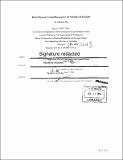Robust dynamic symbol recognition : the ClockSketch classifier
Author(s)
Ma, Kăichén
DownloadFull printable version (9.053Mb)
Other Contributors
Massachusetts Institute of Technology. Department of Electrical Engineering and Computer Science.
Advisor
Randall Davis.
Terms of use
Metadata
Show full item recordAbstract
I present an automatic classifier for the digitized clock drawing test, a neurological diagnostic exam used to assess patients' mental acuity by having them draw an analog clock face using a digitizing pen. This classifier assists human examiners in clock drawing interpretation by labeling several basic components of a drawing, including its outline, numerals, hands, and noise, thereby freeing examiners to concentrate on more complex labeling problems. This is a challenging problem despite its specificity, because the average user of the clock drawing test has a high likelihood of cognitive or motor impairment. As a result, mistakes such as crossed-out numerals, messiness, missing components, and noise will be common in drawings, and a well-designed classifier must be capable of handling and correcting for various types of error. I describe in this thesis the construction of a system that is both accurate and robust enough to handle variable input, laying out its components and the principles behind its design. I demonstrate that this system accurately recognizes and classifies the basic components of a drawing, even when applied to a wide range of clinical input, and that it is able to do so because it relies both on statistical analysis and on common-sense observations about the structure of the problem at hand.
Description
Thesis: M. Eng., Massachusetts Institute of Technology, Department of Electrical Engineering and Computer Science, June 2014. Cataloged from PDF version of thesis. "May 2013." Includes bibliographical references (page 61).
Date issued
2014Department
Massachusetts Institute of Technology. Department of Electrical Engineering and Computer SciencePublisher
Massachusetts Institute of Technology
Keywords
Electrical Engineering and Computer Science.